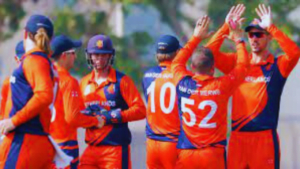NZ vs NED – The Rajiv Gandhi Cricket Stadium in Hyderabad was the perfect setting for Mitchell Santner’s wizardry.
The batsmen from the Netherlands were spotted ferociously dancing on Santner’s spinning balls. The New Zealand team tasted success for the second time in the ICC World Cup 2023 thanks to the bowler who spread the enchantment of his spin and captured five wickets. Santner has contributed to World Cup history in this way as well.
New Delhi’s Sports Desk. Mitchell Santner NZ vs NED:
At the Rajiv Gandhi Cricket Stadium in Hyderabad, Mitchell Santner’s brilliance reached its zenith. The batsmen from the Netherlands were spotted ferociously dancing on Santner’s spinning balls. The New Zealand team tasted success for the second time in the ICC World Cup 2023 thanks to the bowler who spread the enchantment of his spin and captured five wickets. Santner has contributed to World Cup history in this way as well.
Tanner authored the past.
In reality, Mitchell Santner has made ODI World Cup history for New Zealand by being the first bowler to ever capture five wickets in a game. No Kiwi bowler could accomplish this feat before to Santner. In his 10 overs, Santner used 59 runs and claimed five wickets.
The other team’s batsmen were helpless against Santner’s spinning balls.
sparked controversy even with the bat
Mitchell Santner made a lot of noise with the bat in addition to taking five wickets with the ball. In the final overs, Santner batted aggressively and scored 36 runs in only 17 balls. Santner, who had a strike rate of 211 while playing, scored three fours and two skyscraper sixes, which helped the New Zealand team reach a significant total.
New Zealand’s second straight victory
First-innings batsmen New Zealand scored 322 runs while losing 7 wickets in 50 overs. Will Young, who left the field in the previous game without making a run, was sharp in this game and put up a solid inning of 70 runs. Rachin Ravindra, however, scored 51 runs. Tom Latham, the captain, batted quickly and amassed 53 runs on 46 balls. Darryl Mitchell added 48 runs of his own.
The entire Netherlands squad was limited to just 223 runs in response to the Kiwi team’s objective of 323 runs. Santner claimed five wickets, and Matt Henry added three more. Earlier, in the tournament’s opening game, New Zealand defeated reigning champion England by 9 wickets.

NZ vs NED: Such game-winning moments will be revealed in this narrative.
1. Netherlands scored 13 runs on the final ball after beginning with three maidens.
On Monday, October 9 at Hyderabad’s Rajiv Gandhi International Stadium, Netherlands won the toss and decided to bowl first. The team’s bowlers demonstrated that this choice was sound by allowing zero runs in the first three maiden overs. Ryan Kline bowled a maiden, and Aryan Dutt threw two strikes.
New Zealand yet managed to amass 323 runs in 50 overs despite this beginning. In which, on the game’s final ball, 13 runs were also scored. The final ball of the 50th over was bowled by Bas de Leede, who raised his no-ball over his waist. On this, Mitchell Santner hit a six. Santner also struck a six on the subsequent ball, which was a free hit. New Zealand scored 13 runs on the final ball in this manner.
2.Engelbrecht fumbled a simple Daryl Mitchell catch.
In the 32nd over, rookie Sybrand Engelbrecht fumbled a straightforward catch. The fifth ball of the over was bowled by Ryan Kline and was a nice length on leg stump. The ball was flicked by Daryl Mitchell and went directly to mid-wicket defender Engelbrecht, who was unable to grab it.
Mitchell was batting and had already scored 22 runs; he went on to score 26 more runs during his innings. After scoring 48 runs, he was out.
3.Daryl Mitchell is greeted by Van Meekeren.
Paul Van Meekeren, a fast bowler from the Netherlands, met Daryl Mitchell in the 39th over. The second ball of the over was delivered by Meekran and was longer. Mitchell delivered a quick shot back to the bowler, but the ball sailed straight for the non-striker’s end’s stumps. Mitchell was met by Mickran after the ball struck the stumps. Meekran was really close to the ball following Mitchell’s shot, but the ball did not strike him because he narrowly avoided getting struck by it.
4.Mark Chapman made a fantastic high catch that Van der Merwe grabbed.
In the 45th over, Roelof van der Merwe, 38, made a superb high catch. The first ball of the over was bowled by Aryan Dutt and was well outside the off stump. Mark Chapman attempted to play a powerful shot toward further covers, but the ball remained at the point. Van der Merwe, who was positioned at backward point, dove to receive the ball after coming under it.

Here are the highlights of the second inning…
5.Daryl Mitchell fumbled a simple catch that was in the slips.
In the second over, Daryl Mitchell of New Zealand missed a simple catch. Matt Henry delivered the final delivery of the over with a decent length delivery outside the off stump. Daryl Mitchell, who was positioned at second slip, attempted to collect the ball after it struck Vikramjit Singh’s bat, but it missed his grasp.
Vikramjeet had a run advantage at the time of Jeevan Daan. He scored 12 runs, but he was unable to capitalize on this gift of life and was bowled by Henry.
6.Trent Boult of New Zealand grabbed a superb juggling catch at the long off boundary in the 17th over, sparking debate over Bolt’s good attempt on the boundary.
But after making this choice, a dispute developed. Rachin Ravindra actually bowled the fourth ball of the 17th over longer length outside the off stump. Bas de Leede attempted to hit a six over long off, but Trent Boult caught it inside the boundary when he was standing there. Bolt flung the ball into the air even though he had crossed the border due to momentum. He finished the catch by moving inside the boundary.
Bolt was in the air when the ball entered his hands for the second time. Bolt’s final point of contact with the earth was outside the boundary, which is against the new MCC regulations that state the bowler’s feet must be inside the boundary just before completing the catch. He then leaped, grabbed the ball while it was still in the air, and stepped within the line. The umpire should have called a six because of the new regulations, but despite seeing the replays, he still ruled the batsman out. This has also been contested by commentators.
7.Nidamanuru was run out on the following ball after Will Young dropped the catch.
The New Zealand squad made a catch drop in the 26th over, and the very next ball resulted in a run out. Trent Boult bowled the third ball of the over slower and outside the off stump. A tremendous shot was about to be played by Colin Ackerman when the ball pitched near mid-off. Will Young, who was there, attempted to capture the ball, but it escaped his grasp. This ball led to the scoring of 2 runs.
Boult bowled the next ball on the leg stump at a fair length after failing to make the catch. Teja Nidamanuru, who was at the non-striker’s end, ran to collect two runs after Ackerman played a shot towards mid-wicket, but Ackerman declined. After catching Lockie Ferguson’s superb throw, wicketkeeper Tom Latham removed the stumps before Ndamanuru could return to the crease. Nidamanuru scored 21 runs before being run out.
8.The wicketkeeper kept Engelbrecht from being stumped.
Rachin Ravindra bowled leg spin on the opening delivery of the 41st over. Sybrand Engelbrecht attempted a big shot but was unsuccessful. The field umpire asked the third umpire for assistance in making a decision as he was making his way back to the pavilion. Tom Latham, the wicketkeeper, was shown catching the ball before the stumps on replay. The third umpire ruled the batter not out and the ball a no-ball because the wicketkeeper is not allowed to catch the ball in front of the stumps.
The following pitch was a free hit, but Engelbrecht was unable to capitalize. He was batting after having scored 19 runs when he decided to donate his life. As the team’s final batter, he played 29 runs in an inning before being struck out.
